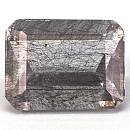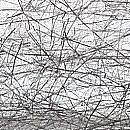|
ClassicGems.net |
|
|
 |
|
Boulangerite (inclusions in Quartz) |
|
|
Discovered in 1835; IMA status: Valid (pre-IMA; Grandfathered) |
|||
|
|
|
Chemistry |
|
|
|
|
|
Pb5Sb4S11 |
|
|
|
Lead Antimony Sulfide |
|
Molecular Weight: |
1,887.90 gm |
|
Composition: |
Antimony |
26.44 % |
Sb |
|
|
|
|
Lead |
54.88 % |
Pb |
|
|
|
|
Sulfur |
18.68 % |
O |
|
|
|
|
|
100.00 % |
|
|
|
|
|
|
||||
|
Classification |
|
||||||||||
|
|
|||||||||||
|
Sulfides |
|||||||||||
|
2/E.19-30 |
|||||||||||
|
|
2 : SULFIDES and SULFOSALTS (sulfides, selenides,
tellurides; arsenides, antimonides, bismuthides; sulfarsenites,
sulfantimonites, sulfbismuthites, etc.) |
||||||||||
|
Related to: |
Homeotype of Lopatkaite. |
||||||||||
|
Varieties: |
Cuprian Boulangerite, Plumosite Boulangerite |
||||||||||
|
Synonyms: |
Acicular Boulangerite, Bolidenite, Embrithite, Epiboulangerite, Mullanite, Orlandinite, Plomb antimonié sulfuré, Plumbostib, Plumbostibiite, Plumites, Yenerite |
||||||||||
|
|
|
||||||||||
|
Crystal Data |
|
||||||||||
|
|
|||||||||||
|
Monoclinic; Point Group: 2/m- Prismatic |
|||||||||||
|
Needlelike (acicular) crystals, to 1 cm, rarely as tiny rings; fibrous, compact, felted masses. Crystals are seldom terminated; striations || [001] strong. |
|||||||||||
|
None |
|||||||||||
|
|
|
||||||||||
|
Physical Properties |
|
||||||||||
|
|
|||||||||||
|
Distinct on {100} |
|||||||||||
|
Irregular/Uneven |
|||||||||||
|
Brittle, flexible in thin crystals |
|||||||||||
|
2.5 - 3.0 |
|||||||||||
|
~ 6.2 (g/cm3) |
|||||||||||
|
Not fluorescent |
|||||||||||
|
Not Radioactive |
|||||||||||
|
|
|
||||||||||
|
Optical Properties |
|
||||||||||
|
|
|||||||||||
|
Dull, lead-gray |
|||||||||||
|
Opaque |
|||||||||||
|
Metallic, may be silky |
|||||||||||
|
R1–R2: (400) 40.5–44.0, (420) 40.0–43.7, (440) 39.5–43.5, (460) 39.0–43.2, (480) 38.6–43.0, (500) 38.2–42.7, (520) 37.9–42.4, (540) 37.6–42.0, (560) 37.2–41.6, (580) 36.8–41.1, (600) 36.3–40.3, (620) 35.8–39.6, (640) 35.4–38.8, (660) 35.0–38.0, (680) 34.6–37.3, (700) 34.1–36.6 |
|||||||||||
|
0.00 |
|||||||||||
|
n/a |
|||||||||||
|
Weak |
|||||||||||
|
Distinct |
|||||||||||
|
|
|
||||||||||
|
Occurances |
|
||||||||||
|
|
|||||||||||
|
Geological Setting: |
In hydrothermal veins formed at low to medium temperatures. |
||||||||||
|
Common Associations: |
Lead sulfosalts, Galena, Stibnite, Sphalerite, Pyrite, Arsenopyrite, Siderite, Quartz |
||||||||||
|
Common Impurities: |
Cu, Zn, Sn, Fe |
||||||||||
|
Type Locality: |
Molières, Gard, Languedoc-Roussillon, France |
||||||||||
|
Year Discovered: |
1835 |
||||||||||
|
View mineral photos: |
|||||||||||
|
|
|
||||||||||
|
More Information |
|
||||||||||
|
|
|||||||||||
|
|
|||||||||||
|
|
|
||||||||||
Boulangerite was named in 1837 by Norwegian chemist Moritz Christian Julius Thaulow (1812-1850) to honor French mining engineer Charles Louis Boulanger (1810-1849). Boulanger discovered the material in 1835 at Molières, Gard, Languedoc-Roussillon, France and called it "plomb antimonie sulfure" (lead antimony sulfide). It was also later named Mullanite from an occurrence near Mullan, Idaho but this name did not last. Boulangerite is a sulfosalt, a segment of sulfides where the antimony acts more like a metal than a non-metal. Boulangerite is one of a few sulfide minerals that form fine acicular crystals that appear as hair-like fibers. Jamesonite and Millerite are two other sulfides that form similar acicular crystals and can be mistaken for Boulangerite. Boulangerite and Jamesonite have been called feather ores and may occur in intergrowths. A variety of Boulangerite is called "plumosite" due to its plumose (feathery) habit and was at one time thought to be a different mineral. Due to the acicular habit of Boulangerite, it is unsuitable for faceting but interesting gems have been cut from Quartz crystals containing inclusions of Boulangerite. Distribution of Boulangerite is widespread; only a few localities can be listed here. In France, at Molières, Gard (the Type Locality), and from Saint-Pons, Alpes-de-Haute-Provence. In rings from Bottino, Tuscany, Italy. In crystals from Sala, Västmanland; Nasafjell, Lappland; and Boliden, Västerbotten, Sweden. At Wolfsberg, Harz Mountains, at Ober-Lahr, near Altenkirchen, Rhineland-Palatinate, and Waldsassen, Bavaria, Germany. From Trepca, Serbia. At Pribram, Czech Republic. In the USA, in the Coeur d’Alene district, Shoshone County, and the Wood River district, Blaine County, Idaho; in the Iron Mountain mine, Superior, Mineral County, Montana; and at Augusta Mountain, Gunnison County, Colorado. As rings in Mexico, at the Noche Buena mine, Mazapil, Zacatecas. From Madoc, Ontario, Canada. |
|||||||||||
|
Boulangerite gems for sale: We have not photographed our Boulangerite gems yet. Please check back soon. |
